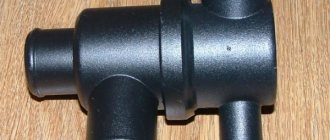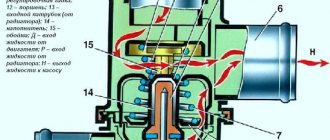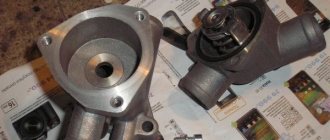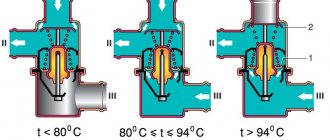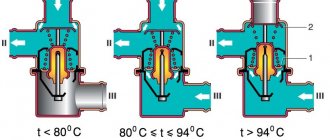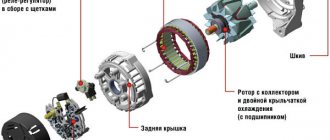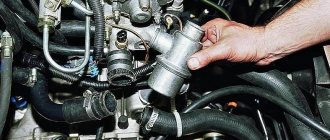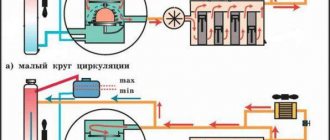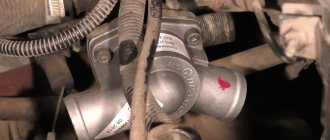The thermostat in the car has gone bad, I’m going to go to the store in a couple of days, but I want to know how to choose the right thermostat, what to look for, what nuances there are, I’ll be glad for any advice!
I’ll tell you, as a long-time car enthusiast, you should only buy original spare parts from the manufacturer.
The thermostat is no exception.
After all, the work of one node directly affects the work of other nodes and it is necessary to make some “improvements” either in a comprehensive manner, or to refrain from doing so altogether.
First of all, you need to remove the thermostat to get an idea of what it looks like.
Further information is needed.
Manufacturer country. in our case it is Russia. City of Togliatti.
This means that the original thermostat is produced at the Volzhsky Automobile Plant, we are not considering a license, imported ones and especially Chinese ones are the same.
Next we look for information about the price. You can go online, you can go to several stores.
Based on the price, we find out about the cheapest ones and immediately exclude them (probably Chinese).
Then we exclude the most expensive ones; VAZ thermostats for classics can also be produced by France (for example), the price is higher, but the quality is no better, and often worse.
Next, we collect information; all classic models up to 7 have the same thermostats, which means we don’t get hung up on the 6.
Suitable from 01, 02, 03, 04, 05, 0.63, 07.
The original packaging must have the VAZ logo, it looks like this.
Now look at the removed thermostat, only the series numbers and production dates should differ, all other numbers should match.
This is the main thing.
Of course, there are thermostats of good quality produced under license, in this case you just need to find out whether this manufacturer has a VAZ license.
The efficiency of the stove and other parameters that affect the operation of the entire engine depend on the engine temperature. The temperature depends on the thermostat. A thermostat is a device that directs coolant through a large or small cooling circle.
Thermostat
A thermostat is a device that regulates temperature. Essentially, it is a shut-off and control device that opens, closes and changes the direction of flow of coolant. There are two cooling circuits in a car engine cooling system: large and small. The large circle is the circulation of fluid through the main radiator, and the small circle is the circulation of fluid bypassing the radiator.
The operation of the thermostat is regulated by a valve, which, depending on the temperature, opens one pipe and closes the second.
What will you need for replacement?
Before starting work, you need to make sure you have:
- New working part.
- Wrenches or socket heads with a ratchet and an extension “10” and “13”.
- Phillips and slotted screwdrivers (depending on the bolt heads of the worm clamps used).
- Containers with a volume of about 10 liters for coolant, preferably low and wide; a basin is perfect for this role. If you plan to reuse antifreeze, the container must be clean.
In most cases, up to three new clamps and at least 1–2 liters of antifreeze, similar to that poured into the car, will also be useful, because it is difficult to completely eliminate coolant loss when draining it. The following will help increase the convenience and efficiency of repairs:
- Socket wrench “7” or “8”, suitable for loosening and tightening clamps.
- Pliers that make it easier to remove the factory-installed band clamps on the Classic.
- A funnel for collecting coolant, for example, cut from a plastic bottle.
Often, replacing the thermostat on a Zhiguli is combined with pouring fresh antifreeze and installing new pipes or other parts of the cooling system. In this case, it is necessary to purchase the appropriate spare parts and coolant (total filling volume is 8.65 liters, that is, a little more than 9.5 kg).
Types of thermostats
Externally, if you take the thermostats of the Niva and VAZ 2101 (kopecks), the differences will not be visible. They have differences inside, the pipes are located differently.
Types of VAZ thermostats:
- Thermostat 2101-2107. The valve began to lock when it reached 80 degrees, and fully opened when it reached 95 degrees.
- Almost the same ones are installed on the VAZ Niva, only the angle between the pipes is about 180 degrees.
- The VAZ 2108 thermostat is installed on all VAZ models with carburetor engines of various modifications. The thermostat valves of front-wheel drive VAZs operate 7 degrees later than those of classic models.
- The thermostat of the VAZ 2110 is the same as the classic one, but the pipes are located in a mirror image. There is no small pipe for air outlet.
- The VAZ 2112 thermostat is made for VAZ injection engines. The valve opens when the temperature reaches 85 degrees.
What is a thermostat?
The thermostat is usually understood as:
- a device used to ensure a given level of ambient temperature (water, air);
- a hardware module designed to measure the temperature of the environment (water or air) and transmit a signal to the control module to activate or turn off the heating (or cooling) elements when the corresponding medium reaches a certain temperature.
Thus, there are 2 main meanings of the term in question.
In the first interpretation, the thermostat acts as an independent device that can be equipped with a variety of functions. Such as, for example, ensuring air temperature according to a schedule or in correlation with its humidity level.
A thermostat in the meaning of “hardware module” can be used as part of a wide variety of devices. For example, in air conditioners, heaters and other types of climate control equipment, in refrigerators (if we are talking about the need to maintain low ambient temperatures).
Which thermostats to choose for VAZ (Lada) 2101/2103/2106?
Last month, PartReview users preferred LUZAR. 60% of positive votes belong to this manufacturer.
Gates thermostats came in second place with 20%.
Vernet closes the top three with 20% of the votes.
In the general rating of thermostats, which takes into account the opinions of owners of different brands and models of cars, these brands occupy the following positions:
- LUZAR received 8th place, PR score - 66. Data from 72 reviews and 229 votes are taken into account.
- Gates is ranked 10th with a PR score of 56 based on 72 reviews and 89 votes.
- Vernet is ranked 6th with a PR score of 70. Data from 66 reviews and 202 votes are taken into account.
Other spare parts for VAZ (Lada) 2101/2103/2106
Having found out which thermostats VAZ (Lada) 2101/2103/2106 owners prefer to install, you can look at other popular spare parts for this car. In June 2022, the leaders on PartReview were:
You can also find out what the owners of VAZ (Lada) 2101/2103/2106 chose among manufacturers of such spare parts as: Pump, Springs, Shock Absorber Struts, Brake Discs, Starter, and others.
If the VAZ 2106 engine suddenly began to overheat for no apparent reason, most likely the thermostat has failed. This is a very small device that at first glance seems insignificant. But this impression is deceptive: if there are problems with the thermostat, the car will not go far. Moreover, the engine, overheating, may simply jam. Is it possible to avoid these troubles and replace the thermostat yourself? Undoubtedly. Let's figure out how this is done.
WHAT ARE THE SIGNS OF A PROBLEM?
This device can get stuck in both the open and closed states, as well as in one of the middle states. Therefore, cooling malfunction can be of two types,
- The engine will overheat and the antifreeze will boil if the valve is closed and the liquid does not enter the radiator. Then, at least for some time, turning on the stove at full heat and maximum airflow can help. Naturally, this option is the most dangerous.
- The engine will take much longer to warm up if the valve is “stuck” open. This is still better than the first option, but the thermostat still needs to be replaced.
Purpose of the thermostat on the VAZ 2106
The thermostat must control the degree of heating of the coolant and react in a timely manner when the antifreeze temperature becomes too high or, conversely, too low.
The device can direct coolant through either a small or large cooling circle, thereby preventing the engine from overheating, or, conversely, helping it quickly warm up after a long period of inactivity. All this makes the thermostat the most important element of the VAZ 2106 cooling system.
Thermostat location
The thermostat in the VAZ 2106 is located to the right of the engine, where the pipes for discharging coolant from the main radiator are located. To see the thermostat, simply open the hood of the car. The convenient location of this part is a big plus when it becomes necessary to replace it.
Principle of operation
As mentioned above, the main task of the thermostat is to maintain the engine temperature within specified limits. When the engine needs to warm up, the thermostat blocks the main radiator until the engine reaches the optimal temperature. This simple measure can significantly extend the life of the engine and reduce wear on its components. The thermostat has a master valve. When the coolant reaches a temperature of 70 °C, the valve opens (it should be noted here that the opening temperature of the main valve can be higher - up to 90 °C, and this depends both on the design of the thermostat and on the thermal filler that is in it used).
The second important element of the thermostat is a special compression cylinder made of brass, inside of which there is a small piece of technical wax. When the antifreeze in the system reaches 80 °C, the wax in the cylinder melts. As it expands, it presses on the long rod connected to the main thermostat valve. The rod extends from the cylinder and opens the valve. And when the antifreeze cools, the wax in the cylinder begins to harden, and its expansion coefficient decreases. As a result, the pressure on the rod weakens and the thermostatic valve closes.
By opening the valve here we mean moving its leaf by only 0.1 mm. This is the initial opening value, which consistently increases by 0.1 mm as the antifreeze temperature rises by two to three degrees. When the coolant temperature rises by 20 °C, the thermostat valve opens fully. The full opening temperature can vary from 90 to 102 °C depending on the manufacturer and design of the thermostat.
Features of the device for the VAZ-2107 car
The thermostat in this model of the classic line is a small cylindrical container that has several, namely three, outlets for pipes. The inlet pipe from the motor is located at the top of the end, and next to it is the outlet pipe. At the bottom is the inlet of the radiator tube.
The device itself has a valve filled with a special substance that expands when the temperature reaches a certain limit. Due to the expansion, the valve piston begins to move and opens it. The valve itself is located in the coolant flow path from the radiator tube to the outlet pipe.
In a VAZ-2107 car, the thermostat also has a bypass valve located on the path of antifreeze movement from the engine to the outlet pipe.
When the engine has just started, and the antifreeze temperature is not high enough, the liquid passes through a small circle. The valve is open, allowing the substance to pass from the inlet of the engine to the outlet. Therefore, the power unit heats up very quickly, reaching operating temperature.
The maximum temperature of the antifreeze (from 80 to 81.5º C) provokes complete closure of the valve, which is why movement occurs only in a large circle, during which the antifreeze cools.
Naturally, like any other mechanism, the thermostat will break down over time. This mainly occurs when the central valve stem jams, which restricts the circulation of fluid selectively in large or small circles.
If the fluid closes in a small circle, this threatens to overheat the engine, but with a large one it is also an unpleasant moment.
The status of the device can be easily checked using a simple test:
- Warm up the engine to operating degrees, at which time the arrow on the device will reach a vertical position.
- Touch the bottom pipe to check by touch how many degrees; it should be barely warm, gradually increasing the temperature.
If it is cold and does not heat up, it means that the antifreeze has closed in a small circle. If the pipes are all the same temperature, then the valve is stuck in the upper position, and the temperature will not change even after the car starts.
Replacing this node is quite simple:
- This work should only be done with a cold engine.
- All coolant is drained.
- The tightening screws are unscrewed.
- The pipes are disconnected from the thermostat.
- The device is replaced and reassembled in the reverse order of dismantling.
Types of thermostats
The VAZ 2106 car was produced for many years. And during this time, engineers made a number of changes to it, including thermostats. Let's look at what thermostats were installed on the VAZ 2106 from the release of the first cars to the present day.
Single valve thermostat
Single-valve thermostats were installed on the very first “sixes” that rolled off the VAZ assembly line. The operating principle of this device has been described in detail above. To date, these devices are considered obsolete, and finding them on sale is not so easy.
Electronic thermostat
An electronic thermostat is the latest and most advanced modification that replaced single-valve devices. Its main advantages are high accuracy and reliability. Electronic thermostats have two operating modes: automatic and manual.
Liquid thermostat
Thermostats are classified not only by design, but also by the type of fillers. Liquid thermostats were the very first to appear. The main component of a liquid thermostat is a small brass cylinder filled with distilled water and alcohol. The operating principle of this device is the same as that of the wax-filled thermostats discussed above.
Solid thermostat
The filler in such thermostats is ceresin. This is a substance similar in consistency to regular wax, which is mixed with copper powder and placed in a copper container. The cylinder has a rubber membrane connected to a rod, also made of dense rubber that is resistant to high temperatures. Ceresin, expanded from heating, presses on the membrane, which, in turn, acts on the rod and valve, ensuring the circulation of antifreeze.
Which thermostat is better
Today, thermostats based on solid fillers are considered the best option for the VAZ 2106, since they have the optimal combination of price and quality. In addition, they can be found in any auto store, unlike liquid single-valve ones, which are practically no longer on sale.
The car is boiling! Replacing the thermostat and pipes
Hi all! I was returning from the city center on Sunday, drove up to the crossing and waited for the train to pass. One has passed, we are waiting for the second... And then, looking at the tidy, I noticed that my temperature had exceeded 90, and the fan still did not turn on. Then it immediately became clear that I had problems with the cooling system. The crossing opened and I hit the gas to at least somehow cool the radiator, additionally turning on the heater. Having reached home (1 km from the crossing), I was already seeing steam from antifreeze coming out from under the hood. I drove the car into the garage and thought that I would walk to work tomorrow. The next morning, I still took the risk of driving. I’m driving, everything is fine, the temperature is normal, if you stay somewhere, it starts to rise. After work I decided to fix the problem. I drove the car into the garage. I drained the antifreeze, removed the battery, and then the thermostat with 3 pipes. At the same time I decided to change the pipes, I bought them back in the winter, but I was still waiting for something. And now, apparently, this moment has come.
I took this set of pipes from Vepa.
The set itself also included a package. It's quite nice to receive such a bonus.
These are the pipes inside.
This is the condition the pipes were in. The lower one for the radiator began to get shaggy.
The thermostat was set at 80 degrees.
The tightening with clamps left deep marks like a pulley.
I unscrewed all the clamps, removed the pipes, and brought the thermostat home to check. It turned out that it did not completely cover the small circle.
I decided to go to the store to get a new one, and at the same time to get a pipe for the top of the radiator. The standard one, which was included in the kit, did not suit me, since I have a different radiator and in it the tube is made at the filler neck. As a result, the store took the upper radiator pipe from the carburetor Seven.
New Belmag thermostat and pipe for the top of the radiator. I cut off one extra bend.
New thermostat. I also checked it before installation.
Old and new thermostat. By the way, the new thermostat is 85 degrees.
Nice and clean thermostat. At 85 degrees.
I assembled the pipes for the thermostat, and next to it there is a ready-made pipe for the top of the radiator.
At the same time I decided to open it and look at the pump. Initially, I was guilty of it, I thought suddenly the impeller on it had flown off and it was not driving antifreeze. It turned out that she was fine. The impeller is cast iron, and the pump itself is from Fenox. In the end, I installed it back on a new gasket.
The pump is still alive, as is the bearing.
Fenox pump.
Filled in antifreeze and started the engine. I waited until it warmed up, after 90 degrees, the fan turned on as expected. I waited another cycle and took the car for a ride. So far everything is working fine.
The new thermostat is sitting in place.
New pipes with thermostat in place.
Lower radiator pipe.
Upper new radiator hose.
Well, that's all! Take care of yourself and your car! Bye everyone!
Signs of a broken thermostat
There are a number of signs that clearly indicate that the thermostat is faulty:
- The light on the instrument panel is constantly on, indicating that the engine is overheating. This usually happens because the thermostat valve has closed and is stuck in that position;
- The engine warms up very poorly. This means that the thermostat valve does not close tightly. As a result, antifreeze flows through both the small and large cooling circles and cannot warm up in a timely manner;
- After the engine starts, the lower thermostat tube heats up literally within a minute. You can check this by simply placing your hand on the nozzle. This situation indicates that the thermostat valve is stuck in the fully open position.
If any of these symptoms are detected, the driver should replace the thermostat as soon as possible. If the car owner ignores the above symptoms, this will inevitably lead to overheating of the engine and its jamming. It is extremely difficult to restore an engine after such a breakdown.
How to check a thermostat when purchasing
When purchasing a new thermostat, blow into the fitting. This will ensure that the fitting is closed as tightly as possible when cooled.
Although this does not guarantee 100% quality, it will at least partially protect you from defects. Unfortunately, there are many defective thermostats on the market now.
Knowing how to check a thermostat, you can always identify a malfunction and avoid damage to the power unit.
Please remember that ignoring failures of this device can lead to engine overheating and failure. The result is even greater costs.
Methods for checking the thermostat
There are four main ways to test the thermostat's functionality. We list them in increasing order of complexity:
- The engine starts and idles for ten minutes. After this, you need to open the hood and carefully touch the lower hose coming out of the thermostat. If the device is working correctly, the temperature of the lower hose will not differ from the temperature of the upper one. After ten minutes of operation they will be warm. And if the temperature of one of the hoses is significantly higher, the thermostat is broken and needs to be replaced.
- The engine starts and idles. After starting the engine, you need to immediately open the hood and put your hand on the hose through which antifreeze enters the upper part of the radiator. If the thermostat is working properly, this hose will be cold until the engine warms up properly.
Video: checking the thermostat
How to get home in such a situation?
Remember that we have another radiator on the Sevens? Although it is small, it may be enough for the return journey without overheating the engine. There is no choice, why not call a tow truck?
- Let the engine cool down as much as possible.
- We open all the windows in the car.
- We start the engine, check that the radiator valve of the cabin heater is open. It is usually closed for the summer.
- Turn on the cabin heater fan. Let it blow on our small stove radiator; we will provide it with some kind of air flow. Open the outside air intake damper.
- Let's start moving.
We stick to a low speed. The motor cannot be revved up too much.
The higher the engine speed, the more often flashes of the air-fuel mixture occur in the cylinders. This means that the heating rate will be greater.
Therefore, we choose the optimal speed mode so that the speed of the power unit does not exceed 2000-2100 (try so hard). This will depend on the design of the fuel system. Below I will tell you how this affects.
We try to slow down with the engine and gearbox
. At this moment, the solenoid valve shuts off the fuel supply to the carburetor. The fuel does not burn, the engine does not heat up.
If the engine speed is above 2000 and the gas pedal is released, the “Forced Idling” system (EFS) comes into operation. This is only the case if the gear is engaged and the clutch pedal is not pressed and you are braking with the engine.
Depending on the design, or more precisely on the control unit of this system, it can be activated when the crankshaft reaches 1900 revolutions and turns off at 1700 revolutions - VAZ 2104,05,07, Lada 2121. Used with a Solex carburetor. By the way, it can also be screwed into Ozone, because the standard pneumatic valve system is unreliable. If you are interested in how to do this, write in the comments. In Ozone, the EPHH turns on at 1600 and turns on at 1200 rpm.
We constantly monitor the engine temperature.
If necessary, we stop and let it cool. But in my case, I am forced to stop only twice while driving through traffic lights. Things were better outside the city.
We independently change the thermostat on a VAZ 2106
Before starting work, you should select tools and consumables. To replace the thermostat we will need:
- new thermostat;
- coolant (5 liters);
- basin for draining old antifreeze;
- flat screwdriver.
It should be noted here that the thermostat cannot be repaired. The reason is simple: inside it has a thermoelement with liquid or solid filler. It is the one that fails most often. But such elements are not sold separately, so the car owner has only one option - replacing the entire thermostat.
Sequence of work
Before performing any manipulations with the thermostat, you need to drain the coolant. Without this operation, further work is impossible. It is convenient to drain antifreeze by placing the car on an inspection hole and unscrewing the cap of the main radiator.
- After draining the antifreeze, the car hood opens. The thermostat is located to the right of the engine. Three hoses come to it.
